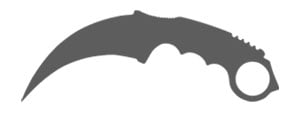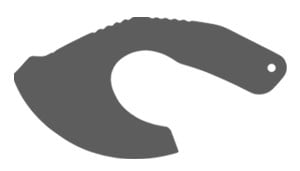Knife Blade Shapes
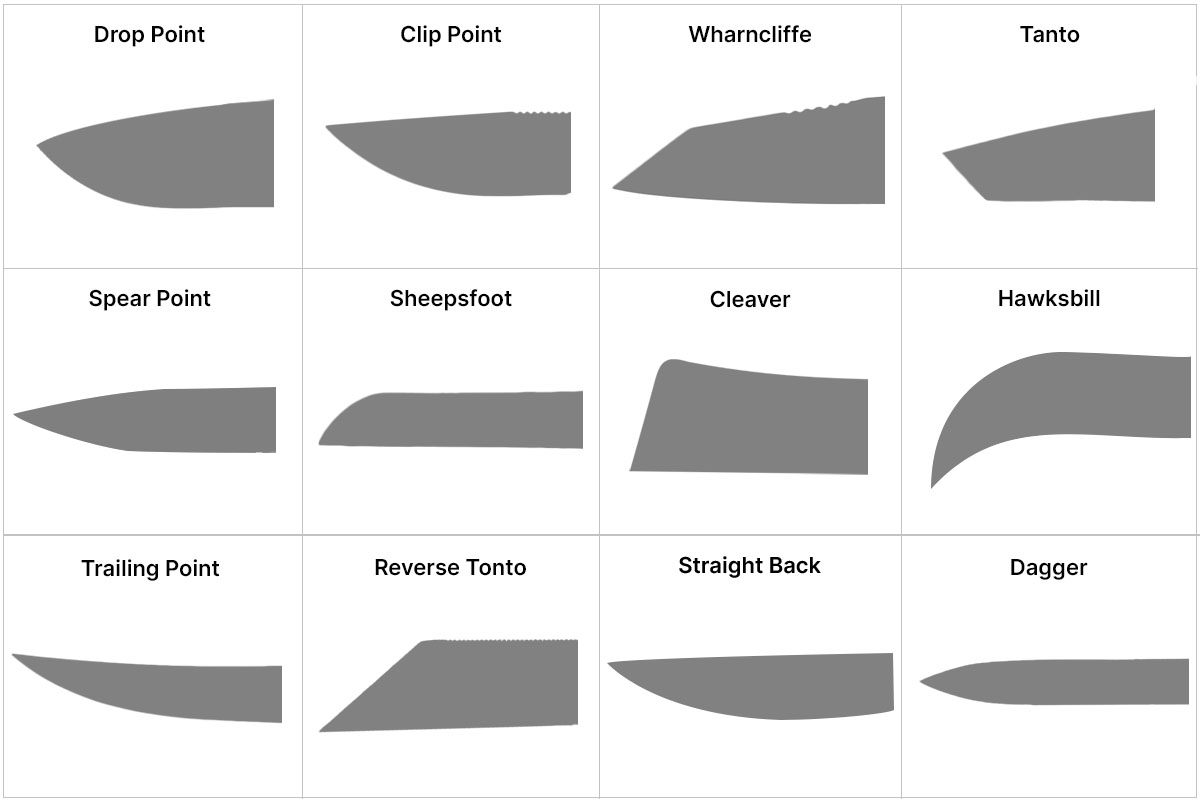
- Blade tip in-line with blade spine
- Narrow to pronounce belly
- Well balanced for piercing and slicing
- Great general use design
- Rounded spin leading into blade tip
- Less risk of piercing injuries
- Slicing, cutting, shaving oriented
- Originally design to care for sheep hooves
- Utility focused
- Similar to sheepsfoot but with a point
- Less aggressive curve to allow for more piercing capacity
- Handles cuts and slicing well
- Originally designed for woodworking
- Suitable for Tactical and Utility purposes
- Wide blade with little to no point
- Designed for chopping and cutting
- Better at resisting impacts
- Utility focused
- Blade tip extends behind initial spine angle
- Allows for longer, consistent cuts
- Generally long narrow belly
- Great for processing meat
- Related to persian style blades
- Spine curves to a point in-line with spine angle
- Good penetrating power with cutting ability
- Well balanced for utility and self-defense
- Tip of the blade offset from spin close to the middle of the blade
- Narrow to pronounced belly
- Great utility knife
- One of the most common blade designs
- Semi-curved to extremely curved blade
- Blade curves forward from handle
- Single to double edged
- Ring built into handle
- Primarily tactical, but originally a utility knife
- Blade tip more centerline, with profile narrowing to a point
- Attempts to balance piercing and cutting ability
- Commonly found on fighting knives
- Utility blade with heavy leanings towards self-defense
- Generally medium to long blade lengths
- Usually features some form of clip point
- Often designed as a fighting knife with utility features
- Great for hunting, bushcrafting, or self-defense
- Central blade point inline with the middle of the blade
- Often single edged
- Partially sharpened rear edge often referred to as a “Bayonet point”
- Strong piercing ability, minor cutting ability
- Almost blunted point with pronounced belly
- Originally used to neuter livestock with less risk of injury
- Very utility oriented
- Double edged version of the spear point
- Almost entirely combat oriented
- Blade variations determine cutting capacity
- Thrust/piercing centric blade
- Blade tip extends forward beyond cutting edge
- Great for general utility and some tactical applications
- Found on harvesting and aquatic related knives.
- Predominately used for pruning, cord cutting, and carpet
- Blade tip is placed on the end of the cutting edge
- Mirrors Americanized-Tanto shape
- Good piercing power with cutting ability
- Similar to Wharncliffe blades
- Large semi-circular blade
- Traditional general purpose knife of the Inuit and other native peoples
- Designed to skin animals, process food,and other day-to-day tasks
- General blade design with normal tip removed
- Tip removal is done for safety or legal requirements
- General purpose or training knife
- Can be found on some emergency/paramedic oriented blades as well as dive knives
- Blade features a long, wide belly with subdued tip
- Designed for bushcraft and survival
- Heavily emphasizes cutting and slicing
- Piercing oriented blade
- Comes in Americanized and Traditional styles
- Geared toward self-defense with some utility
- Americanized versions feature more straight edge angles and little belly
- Traditional versions have broad to narrow bellies
- Blade tip features recessed, rear facing edge
- Designed to make skinning and gutting easier
- Hunting oriented
- Large forward curved blade
- Produces powerful chops and cuts
- Point can be narrow or wide depending on design
- General bushcraft and combat knife
- Traditional knife of the Gurkhas
- Blade designed for scraping and carving
- Blade tip depends on knife design
- Blade style exclusively used in woodworking
Straight Back

The straight back blade is one of the most standard blade designs. It forms the basis for most other knife variations and features a straight spine that goes into the tip. This allows for a long belly depending on the thickness of the knife.
The straight back blade is a very well balanced design for cutting and piercing. Depending on the belly length and how narrow the blade is, straight back knives can rival spear points and daggers for piercing power. They also cut very well.
This versatility is why straight back knives are found in standard kitchen knives, EDC fixed blades, and some folding knives.
Sheepsfoot

The sheepsfoot knife was originally designed to help care for and trim the hooves of sheep. The straight edge of the knife and the curved spin allow this knife to cut and shave material easily. This design is heavily geared towards utility, handling most cutting tasks but unable to do much piercing.
A number of other blades are often confused with the sheepsfoot, predominately the Wharncliffe blade style and the reverse tanto. However, neither of these designs are related to the sheepsfoot beyond being non-standard blade shapes.
Wharncliffe

The Wharncliffe design dates back to 1832 and is named after the first Lord of Wharncliffe. The blade was originally meant to be a whittling knife that featured the exact opposite parameters of knives at the time. The Wharncliffe blade would have a long straight edge with a curved spine and a broad blade profile.
This would turn the Wharncliffe into an exceptional cutting knife that still possesses a prominent point. This allows the knife to do fine tip work in addition to rough cuts and slashes. The convex spine and its sharp curve are what differentiate the Wharncliffe from the sheepsfoot blade.
Cleaver

Cleaver style blades ignore piercing ability in favor of cutting, chopping, and shaving power. Perfect for areas that might have issues with pointed knives, cleaver style blades have no noticeable point. But they do have an obvious cutting edge.
Cleavers have relatively wide and heavy blades. This allows them to power through tough material while directing all of the force to the cutting edge.
Trailing Point

Trailing point blades have the tip of the knife extend past the spine of the blade, letting the point “trail behind” the knife. This allows for a lot of cutting potential, especially with single, long slices. This is why trailing points are usually found on meat processing knives.
While trailing points usually have very aggressive looking points, the blade shape diverts most force towards the edge of the knife. Cuts, slashes, and slicing are where this blade style shines with minimal piercing power.
Persian

Persian style blades have a recurve blade that places the tip in line with the spine of the knife. This creates a very long cutting edge that allows for easier cuts and slices. This is perfect for blades that need to deal with a lot of dense material (meat, cardboard, etc.).
Since the tip of the blade comes back in line with the spine, Persian blade styles can still pierce material very well. This is the major difference between a Persian style blade and a trailing point blade.
Drop Point

Drop point knives are one of the three most common knife designs and feature a slight slope of the blade's spine. This allows for a stronger knife since the blade itself can have a thicker spine for more of the blade.
Drop point knives tend to have good cutting capacity with pronounced bellies. This makes them a very good utility knife that still can pierce material. That piercing ability depends on how thick the blade’s profile is with narrow blades piercing easier than wide blades.
Karambit
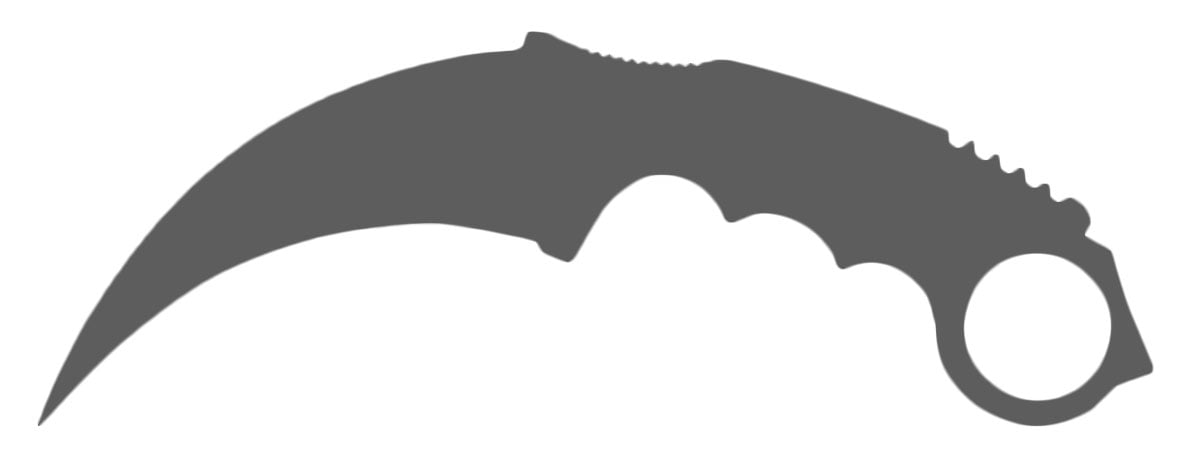
Karambits are a traditional knife design from Southeast Asia and are closely related to Filipino martial arts. It usually consists of a curved or semi-curved blade with one or more edges and a ring built into the handle.
Karambits originally were a form of utility knife, similar to a small hand sickle. Over time they were adapted as a fighting knife, with most modern examples falling under tactical knives. Traditional karambits have double edged blades, but as interest in the knife style grew in the US, more single edge versions were made to comply with US knife laws.
One of the major benefits of a karambit is the ring built into the base of the handle. This helps with retaining the knife in the hand while climbing, moving around, or fighting and is the primary distinguishing feature.
Clip Point

Clip point blades are one of the more versatile blade designs. They combine good piercing ability with cutting ability. This comes from the blades overall shape. Clip point blades feature a drop or clipping of the spine that lowers the tip of the blade closer to the centerline.
This allows for a long, full blade belly and a point that is narrower than the blades overall width. The narrower point and profile of the knife allows for better piercing without sacrificing cutting power. Clip points have been found as far back as flint knives with one of the most popular variations being the Bowie knife.
Bowie

Bowie knives are generally medium to large knives that attempt to balance utility with combat effectiveness. Originally designed as a fighting knife, the Bowie knife takes its name from James “Jim” Bowie. The style became popular after Bowie won a duel just north of Vidalia, Louisiana.
Bowie knives traditionally have blades ranging from 5 inches to 12 inches in length, with a clip point blade, and some form of handguard. Smaller variations and different blade patterns exist. But the modern Bowie knife will have a clip point at the minimum.
A Bowie’s point is separated into two major variations: California clips and Turkish clips. California clips have a more pronounced clip, sometimes taking up half of the blade’s spine. Turkish clips tend to recurve the blade, with some variations making a “C” shaped clip. The rear edge of a Bowie blade may be sharpened, swedged/narrowed, or completely blunt.
Spear Point

Spear point blades feature a point that is in-line with the center of the blade. This allows for a reinforcing rib or fuller to be placed in the blade to strengthen the blade’s tip. The edge and spine usually mirror each other while coming together at the point of the knife.
This style of blade is very good at piercing. Some variations provide a usable blade belly to make the knife have better utility. However, spearpoint knives excel at using the tip of the blade to scratch and pierce material.
A variation of the spear point blade is the bayonet point. This features the base spear point shape but includes a partial edge on the spine of the blade and was commonly found on bayonets, creating the term.
Spey

Spey blades were originally designed to make neutering animals safer. Spey blades do not have a pronounced point to lessen the chance of accidental piercing important areas of the animal.
Spey blades emphasized cuts and slices, making this a great skinning knife. Spey blades are very utility oriented and are a good alternative to Sheepsfoot and Wharncliffe blades.
Dagger

Daggers are the double edge versions of spear point knives and are usually some type of fighting knife. While dagger blades have changed over the centuries, today a dagger consists of a blade with two edges and a very sharp point.
Daggers can have wider bellies that allow for more cutting capacity and better tip retention. Sometimes daggers will have very fine tips with very little belly to the blades. This allows the dagger to piercing materials easier with a higher risk of breaking the tip. These types of dagger blades are usually referred to as needle point blades.
Daggers will normally have ergonomic handles that feature some method of keeping the hand in place during use. This can be a guard/hilt, finger knurl, or grip texture.
Hawksbill

Hawksbill, sometimes referred to as a Hawkbill or Talon, style blades feature a forward curved blade design. Similar to a cat’s claw, this allows a small blade to generate more cutting ability. The curvature allows the point and edge to dig into material easily. The more aggressive the curve, the more edge contact you will get, and the easier the blade will cut.
The style of blades are found on pruning knives, karambits, and some types of diving knives. The hooked blade provides more leverage making it a perfect tool for dealing with ropes and other cordage.
Reverse Tanto

A reverse tanto blade looks like a combination of knife designs. In practice the abrupt angle of an americanized Tanto blade is shifted from the edge to the spine of the blade. This produces a continuous cutting edge while maintaining the reinforced point of the tanto.
The reverse tanto features aspects of the Americanized tanto, combined with clip point and Wharncliffe aspects. This allows for a blade that has a lot of cutting power that is still capable of piercing materials with less risk of the tip breaking.
Ulu
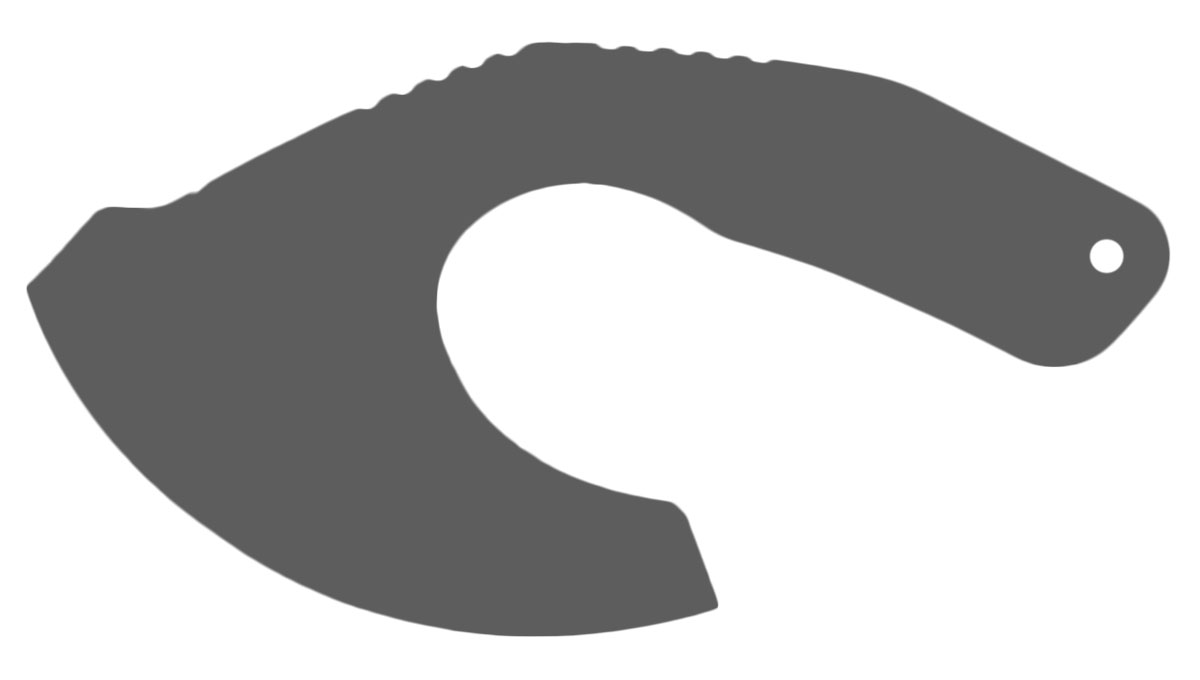
The Ulu or Uluit is a traditional knife design of the Inuit peoples of Alaska and is found across Canada, Western Russia, and Greenland. It is characterized by its semi-circular blade that is attached to various handle styles.
The blade is designed to use a rocking motion when cutting. This pins the material in-place, making one-handed cutting easier. It can be used to skin and clean animals, making it a utility focused blade design. The handle can be one piece with the blade or a separate material like other knives.
Blunt Tip

Blunt tip knives are generally designed for environments where the risk of accidental punctures are higher. This means diving knives, rescue knives, and emergency knives.
Using a knife in a complex and dynamic environment increases the potential for injury, especially in awkward locations. To avoid accidentally hurting someone in need of rescue or themselves, rescue crews and divers will often carry blunt tipped knives. This leaves them with one or more cutting edges to deal with things like rope, clothing, or rubberized materials.
Nessmuk

The Nessmuk blade style was popularized in the 1880s by George Washington Sears, an outdoorsman who wrote various letters to the Forest and Stream magazine under the pen name Nessmuk. The overall design is taken from a singular description in Sears’ book Woodcraft in 1884.
However the design’s origins are still a mystery. The Nessmuk is very similar to early colonial knives that were adopted by hunters and traders in the 1700s, but no one knows for sure how Sears settled on the design.
The long bellied blade was light and narrow, favoring cutting ability over durability. Sears adhered to the belief that tree chopping on other practices were better handled with axes and hatchets than knives. The Nessmuk is still a good bushcraft option with custom manufacturers still producing it.
Tanto

Tanto style blades originated in Japan and feature a thrust-centric single edge design. It was popularized in the U.S. by Cold Steel sometime in the 1980s. From then on it was used in both fixed blade and folding knife designs.
While the blade retains decent cutting capacity depending on the variation, the tanto is a very strong thrusting knife. The overall design reinforces the point and allows the edge to help cut an opening as it is pushed through material.
This makes it fantastic for going through tougher materials, but detracts from its use as a utility knife. Many self-defense knives will feature a tanto style blade. Tantos are generally classified into two major variations: Americanized tantos and Traditional/Japanese tantos.
Americanized Tanto
Americanized tantos are characterized by an abrupt change to the edge angle. This produces a diagonal line from the primary cutting edge to the tip, putting a tip facing edge at the top of the knife. This makes it look like a double beveled kiridashi was fused to a straight back blade design.
This forward facing angle helps the tip cut open an entry way for the blade, but removes the blade’s belly. This lack of belly can make it harder to cut with an Americanized tanto. Some manufacturers will make the edge towards the tip of the blade more curved. This adds a narrow belly to the blade, giving it better cutting utility.
Traditional/Japanese Tanto
While Traditional Japanese Tantos feature several variations in their blade designs, most will feature some type of blade belly. This primary difference between the Traditional and Americanized Tanto points allows the Traditional versions to balance their cut and thrust capabilities.
Traditional tanto blades will feature either a longer secondary blade angle or a gentler narrowing of the blade to produce the cutting edge. This produces a long narrow belly with some variants having a relatively wide belly designed to reinforce the blade point.
Traditional tanto blades on modern production knives are not as widespread as Americanized blades, with most examples being designed by James Williams with CRKT
Gut Hook

Gut Hook knives feature a small recessed edge on the back of the blade. This edge creates the “hook” for the gut hook. It is used to cut through narrow sections of hide and the abdominal section of game animals.
This makes the process of gutting easier with less risk of puncturing the stomach or intestines of the animal, which would contaminate the meat. This style of knife is often used by hunters for faster processing or by those who are just getting into hunting.
Kukri

Kukri style knives are usually very large blades ranging from 10 inches to 15 inches. The blade features a heavy forward curve with a flared belly. Often classified as a type of machete or short sword, kukri have been used for centuries as a general use tool and weapon.
Most of the knife’s weight can be found in the blade, emphasizing cutting and chopping motions. This allows the user to cut through thin branches, reeds, etc. The kukri is used to clear land, process food, slaughter animals, cut firewood, and everything in between. This is one of the reasons why the kukri is a favorite blade option for bushcraft.
Hook

Hook blades or Wood hook blades are traditional wood carving tools. They are designed to “scoop” out wood to create designs, depressions, or planned cavities in lumber.
Hook blades are entirely utility oriented. While they can be used outside of the woodworking sphere, they are optimized for carving and shaping wood. If you are getting into wood carving you will probably have several different variations of hook knives for different carving angles, depths, and widths.







